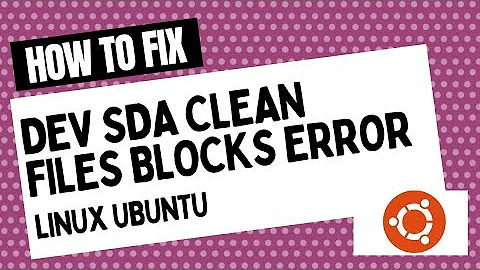Resize Ubuntu /dev/sda1 partition in VirtualBox VMDK when /dev/sda is already larger
You have to first resize the partition with the following steps:
sudo parted /dev/sdato enter the prompt "(parted)" as the superuserresizepart 1to resize the partition1-0resizes it to the end of the disk.-indicates that it should count from the end of the disk, not the start. This makes -0 the last sector of the disk - which is suitable when you want to make it as big as possible. Step 4:quitto exit parted
The file system meta information needs to indicate the size of disk, and resize2fs updates this. Thus, after expanding, run resize2fs /dev/sda1.
It's highly recommended to do this in either single user mode / recovery mode, or with the file system mounted in read only mode. You can mount it read only by mount -o remount,ro /dev/sda1.
Extending is possible to do with filesystem in RW-mode, but it increases chances of data loss. As this is a VM, and you can easily make a backup, doing it with the volume mounted RW may make sense.
Addendum: run commands as root for desired effect.
Related videos on Youtube
Daniel F
Updated on September 18, 2022Comments
-
 Daniel F over 1 year
Daniel F over 1 yearSome time ago I created a VMDK which was mapped to a raw partition on a SSD.
The SSD was a 128GB one, I partitioned it in Windows (the host), made the second partition accessible to Windows (NTFS), and used the first partition to map it into a VMDK.
This first partition has a size of about 48GB.
When I then installed Ubuntu Server in a VM which used that VMDK, I noticed that the size of
/dev/sdashown to me was the 128GB, but I created the partition during the Ubuntu installation to be of the size of the first partition, so that/dev/sda1is of 48GB.Due to the lack of space on
/dev/sda1(there are 5GB free) I bought another SSD, and decided to stop using raw mappings. I copied the VMDK via the Virtual Media Manager onto the new SSD, so there I now have a VMDK file of aprox. 44GB (don't take it very exactly, it's the MiB vs GiB vs GB issue).I thn replaced the HDD of the VM with the newly copied VMDK and booted it. It works as expected.
Now I have this:
:~$ cat /proc/partitions major minor #blocks name 11 0 58100 sr0 8 0 125034840 sda 8 1 46873600 sda1 8 16 488386584 sdb 8 17 181189085 sdb1this
~$ sudo fdisk -l Disk /dev/sda: 119.2 GiB, 128035676160 bytes, 250069680 sectors Units: sectors of 1 * 512 = 512 bytes Sector size (logical/physical): 512 bytes / 512 bytes I/O size (minimum/optimal): 512 bytes / 512 bytes Disklabel type: dos Disk identifier: 0x000271d1 Device Boot Start End Sectors Size Id Type /dev/sda1 * 2048 93749247 93747200 44.7G 83 Linux Disk /dev/sdb: 465.8 GiB, 500107862016 bytes, 976773168 sectors Units: sectors of 1 * 512 = 512 bytes Sector size (logical/physical): 512 bytes / 512 bytes I/O size (minimum/optimal): 512 bytes / 512 bytes Disklabel type: gpt Disk identifier: 59B4B505-C79F-11E3-8F9C-709E29CA19D2 Device Start End Sectors Size Type /dev/sdb1 34 362378204 362378171 172.8G Linux filesystemand this
:/$ df -h Filesystem Size Used Avail Use% Mounted on udev 7.9G 0 7.9G 0% /dev tmpfs 1.6G 9.1M 1.6G 1% /run /dev/sda1 44G 37G 5.1G 88% / tmpfs 7.9G 1.1M 7.9G 1% /dev/shm tmpfs 5.0M 0 5.0M 0% /run/lock tmpfs 7.9G 0 7.9G 0% /sys/fs/cgroup windows-avconv 1.9T 1.8T 103G 95% /home/user/windows-avconv windows-storage 1.9T 1.8T 103G 95% /home/user/windows-storage windows-share 50G 101M 50G 1% /home/user/windows cgmfs 100K 0 100K 0% /run/cgmanager/fs /dev/sdb1 170G 91G 72G 56% /media/hdd tmpfs 1.6G 0 1.6G 0% /run/user/1000All of this seems to indicate that I can just issue a
sudo resize2fs /dev/sda1and then
/dev/sda1will grow to become 119.2 GiB big without me needing to useVBoxManage modifyhd <absolute path to file> --resize <size in MB>Am I correct with this assumption?
Update: I made a backup copy of the VMDK and issued a
:~$ sudo resize2fs /dev/sda1This is the result:
resize2fs 1.42.13 (17-May-2015) The filesystem is already 11718400 (4k) blocks long. Nothing to do!Do I need to issue a
sudo growpart /dev/sda 1before
resize2fscan work?-
 vidarlo over 6 yearsYou need to extend the partition first, yes. I assume growpart can do this. The traditional way would be to use gparted to extend it, or some other modification utility. The Ancient(TM) way of doing it is deleting the partition, and creatinng it with the same starting point, and a new end.
vidarlo over 6 yearsYou need to extend the partition first, yes. I assume growpart can do this. The traditional way would be to use gparted to extend it, or some other modification utility. The Ancient(TM) way of doing it is deleting the partition, and creatinng it with the same starting point, and a new end. -
 Daniel F over 6 yearsThanks, this is a headless machine, so no
Daniel F over 6 yearsThanks, this is a headless machine, so nogparted. I'm confused. So doesresize2fsresize the usable space inside the partition to be the max space of the partition, andgpartedorsudo parted /dev/sda resizepart 1 ???Mthe actual size of the partition/dev/sda1? I thought the file system was always the size of the partition, am I mistaken here? Is there an option forpartedto use the entire/dev/sda? -
 vidarlo over 6 yearsPosted as answer :)
vidarlo over 6 yearsPosted as answer :)
-
-
 Daniel F over 6 yearsSounds very promising, will do it and give feedback
Daniel F over 6 yearsSounds very promising, will do it and give feedback -
 Daniel F over 6 years
Daniel F over 6 yearsparted: invalid option -- '0':( -
 vidarlo over 6 yearsSorry! Tested just now. If you run
vidarlo over 6 yearsSorry! Tested just now. If you runsudo parted /dev/sda, and in parted doresizepart 1and enter -0 as size it works :) Just tested here in a VM. I was stupid, and assumed you could pass parameters like that. -
 Daniel F over 6 yearsI did this in single user mode (or recovery, not sure, in single I chose
Daniel F over 6 yearsI did this in single user mode (or recovery, not sure, in single I choseenterto enter maintainence mode). It did warn me that it is mounted as R/W. Is that warning harmless in that mode? -
 vidarlo over 6 yearsIt's not harmless, but there's fewer processes doing disk IO, so it's safer. Anyway, extending a disk is not a particularly dangerous operation, as the full filesystem still is there.
vidarlo over 6 yearsIt's not harmless, but there's fewer processes doing disk IO, so it's safer. Anyway, extending a disk is not a particularly dangerous operation, as the full filesystem still is there. -
B. Shea over 5 years"
Error: Can't have overlapping partitions." when using "-0" I had to remove my ext part+swap partition (it wasn't being used).




